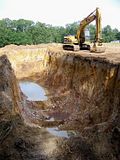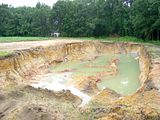One pond will be about 7 acres and the other would be somewhere between 1/5 and 1/2 acre. The surface of the smaller pond is 5 or 6 feet higher in elevation than the big pond surface. The ponds would be 300-400 feet apart. Would it be practical to maintain the water level of the small pond by pumping it from the larger pond? Currently the nearest electricity is 1000 feet from the ponds.
if the small pond has a steady influx of groundwater, maybe the small pond could help keep the big pond topped off?Clay is being harvested for Cindy's big pond from the adjacent field. While digging the clay we found springs
(i think this might be groundwater as opposed to springs, but this could just be semanitcs, if springs they have positive pressure and with groundwater it would be the water table at equilibrium....build a pond with hopes of filling above level of groundwater, and it could reverse on itself and only stay at the static groundwater level (i.e. never fill) and so we're considering creating this small pond from the clay pit. The problem is that we don't know if the springs will be enough to keep the little pond full.
(how long will the equipment be on-site? if you get a dry run in the weather, you should be able to guage water levels and make a determination before equipment leaves as to whether or not it will stay full and only lose by evaporation) The original plan was to fill the clay pit with material from the big pond once the core was completed. If we choose to build the small pond and there isn't sufficient water then filling it in later will be very expensive. That safe thing to do is fill it in now, but the springs look promising and who wouldn't want an extra little pond?
The little pond would be fairly high in elevation and would have almost no watershed. Because of the grade it will be an eyesore if it doesn't stay fairly full. If we knew we could keep the little pond full using water from the big one for a reasonable cost it would make the decision easier.
(pumping water is expensive, and as mentioned above, you need to first be able to guage whether or not its losing via groundwater pathways)There is no extra cost for building the small pond because it eliminates the need to fill in the clay pit which would take about a week to do.
This photo is for scale and was taken 7/31. I'm guessing the pit is about 16 feet deep.

Here's the pit on 8/16. More clay had been harvested and the drop at the right rear corner from the grade to the water was 10-12 feet in this photo. You can see the larger pond through the gap in the trees.

This shot is a few weeks after tropical storm Fay left about 15 inches of rain. There are 3-4 acres of watershed from the cotton field that helped fill the pond and I suppose also supplied the fertilizer to create this algae bloom. The water depth was about 14 feet. Above this water level the soil changes from clay to sand.
 (i'm jealous.....thats beautiful, i hope it holds. my suspicion though is you dug to groundwater level, go any deeper and you risk breaking into a porous layer that you can lose water to)
(i'm jealous.....thats beautiful, i hope it holds. my suspicion though is you dug to groundwater level, go any deeper and you risk breaking into a porous layer that you can lose water to)If we build this pond then we will eliminate any runoff from the field.
(does the run off go to the big pond....not sure i understand based on yer description) When these photos were taken the core was only half finished so a lot more clay is being taken from the pit.
(my advice is if you want the little pond, borrow remaining clay laterally, dont dig any deeper, and you might be able to use some clay on the upper sides of the slopes if upper soils are sandy) At this point the contractor is forming slopes as he digs in case we decide to build the little pond.